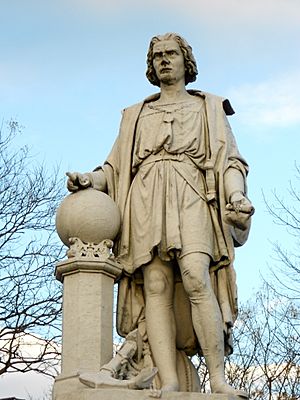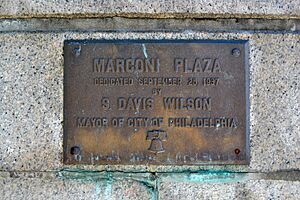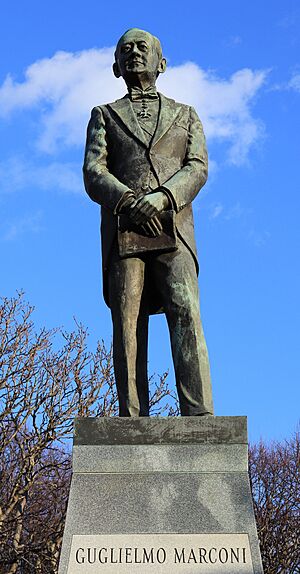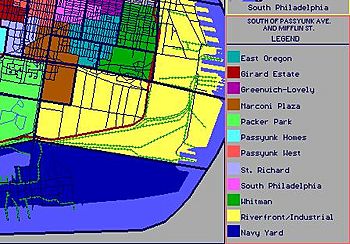Marconi Plaza facts for kids
Quick facts for kids Marconi Plaza |
|
|---|---|
| Type | Urban park |
| Location | Philadelphia, Pennsylvania |
| Area | 19 acres (7.7 ha) |
| Created | 1914 |
| Operated by | City Parks & Recreation |
| Visitors | 150,000 |
| Status | Open all year |
| Public transit access | Oregon Station |
Marconi Plaza is a public park in South Philadelphia, Pennsylvania. It is named after Guglielmo Marconi, a famous Italian inventor. The park is a special place for the Italian American community in Philadelphia. It also hosts the yearly Columbus Day Parade.
The park is split into two parts, east and west, by Broad Street. It is at the southern end of the city, near the Sports Complex. You can easily get there by subway using the Oregon Avenue station.
Marconi Plaza is a rectangular park, about 19 acres in size. It is divided by Broad Street. The park is surrounded by 13th Street, 15th Street, Bigler Street, and Oregon Avenue.
Contents
Park History
The design for Marconi Plaza was influenced by famous architect Paul Philippe Cret in 1904. He helped review the plans from the Olmsted Brothers, who then finished the design.
The Plaza later served as a grand entrance for the 1926 Sesquicentennial Exposition. This was a big fair held in Philadelphia. Visitors would walk south along a tree-lined street called Southern Boulevard Parkway to reach the fairgrounds.
This park became part of the Fairmount Park system. It was first known as Oregon Plaza. But on October 18, 1937, it was officially named Marconi Plaza. This honored Guglielmo Marconi, who won a Nobel Prize for inventing radio.
The F. Amadee Bregy School nearby was added to the National Register of Historic Places in 1988.
Park Design
The original design of the Plaza featured a two-level terrace. It had pathways, marble decorations, and urns. The design was inspired by beautiful Roman gardens and English gardens.
Both the east and west parts of the plaza had similar winding paths. These paths led to a raised terrace with stone railings. At the entrance, there were large urn sculptures. There were also two small "reflecting" pools of water facing Broad Street. These pools were later filled in.
Today, the park is full of trees, covering about 25% of the area. It has park benches and open spaces. There are also two tot lots, a baseball field, a basketball court, and an enclosed bocce court. The sidewalks around the park are lined with tall maple trees, reaching 30–50 feet high.
Public Art in the Park

Guglielmo Marconi Statue
A bronze statue of Guglielmo Marconi stands on the east side of the plaza. It was sculpted by Saleppichi Giancarlo. The statue was put in place in 1975 by the "Marconi Memorial Association." This group was formed by the Italo-American Community. The statue was officially dedicated on April 25, 1980. This date marked 106 years since Marconi's birth.
Christopher Columbus Statue
A marble statue of Christopher Columbus was placed on the west side of the plaza in 1976. This statue was first located in Fairmount Park. It was first shown to the public on October 12, 1876, for Philadelphia's Centennial Exposition.
This statue is believed to be the work of Emanuele Caroni. It is said to be the first public monument to Christopher Columbus funded by the public in the United States. Italian-Americans and the Columbus Monument Association raised $18,000 to buy it.
The statue's first location started a tradition. Italian Americans in South Philadelphia would march to the statue in Fairmount Park every year on Columbus Day. The journey was long, about 6 miles. So, in 1920, the celebration moved to a new location.
Discussions about the Columbus Statue
Over the years, there have been discussions about the Christopher Columbus statue.
- In 2018, during protests on Columbus Day, the words "Italian-Americans against racism" were painted near the statue.
- In June 2020, after the George Floyd protests, some statues of historical figures became targets for vandalism. Some members of the Italian-American community gathered at Marconi Plaza. They wanted to protect the Columbus statue, which they saw as a symbol of their heritage.
- City officials decided the statue would stay for a while. On June 17, city workers covered it with a wooden box to protect it.
- On August 12, 2020, the Philadelphia Art Commission ordered the statue to be removed from Marconi Plaza. It was moved to temporary storage. This decision was made after the Philadelphia Historical Commission agreed to the city's plan. They noted concerns about public safety and possible damage to the statue during protests.
Neighborhoods Around the Park
Marconi East: Residential Areas
The Mollbore Terraces of Marconi were built in the 1930s. This was a new kind of urban design for South Philadelphia. Unlike the usual row houses, these homes had front porches and backyards. They also had a service road for trash collection.
Three Mollbore Terrace sections were built east of the plaza. They were located between 13th Street and 7th Street, and from Oregon Avenue to Johnston Street. The streets were laid out differently from the usual grid. This allowed for small "mini-public-squares" of green space. Homes faced inward onto these green areas. Each large rectangular park space was called a "Terrace." They had pathways, grass, trees, and a wading pool.
Marconi West: Residential Areas
The Roman Terraces of Marconi are homes west of the plaza, from 15th to 19th Street. They use a similar design concept but on a smaller scale. They include two oval-shaped terrace streets at Smedley and Colorado. The terrace at Colorado Street became famous citywide. From 1950 to 2000, it was known for its amazing Christmas decorations and lights.
The Moyamensing Avenue Parkway of Marconi is a main street with a wide, landscaped median in the center. It crosses the standard street grid. This road was designed as an alternative way to get to the 1926 Sesquicentennial Exposition. It starts at Oregon Avenue and goes to the intersection of 20th Street, Penrose Avenue, and Packer Avenue. City planners had once planned a grand public square at the end of the parkway, similar to those in Center City Philadelphia. However, this square was never built.
Park Boundaries
In 2002, the City of Philadelphia set official boundaries for the Sports Complex Special Service District. These boundaries included the residential communities around Marconi Plaza. This special district helped define Marconi East as community 3 and Marconi West as community 4.
Images for kids






